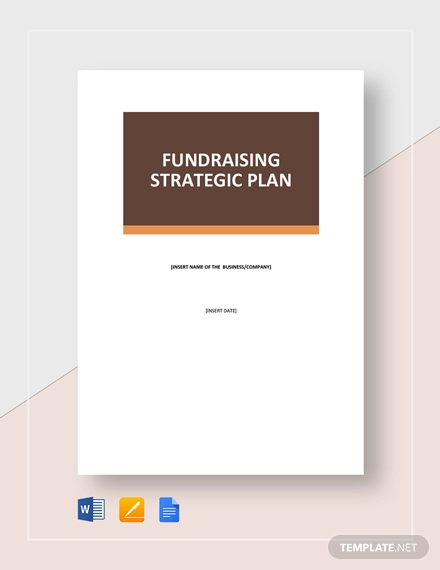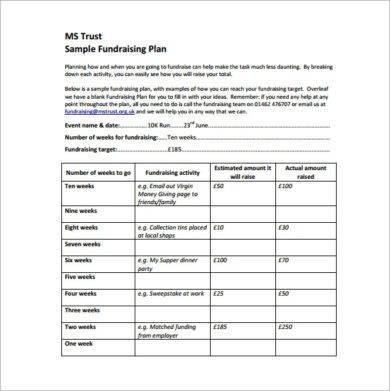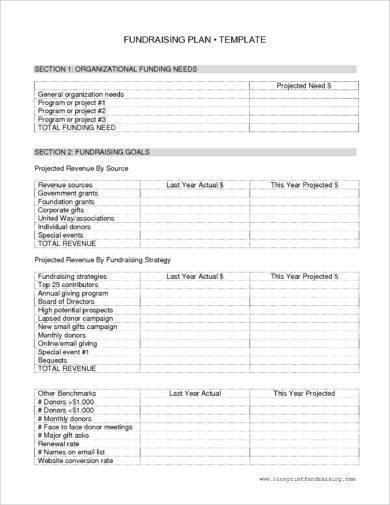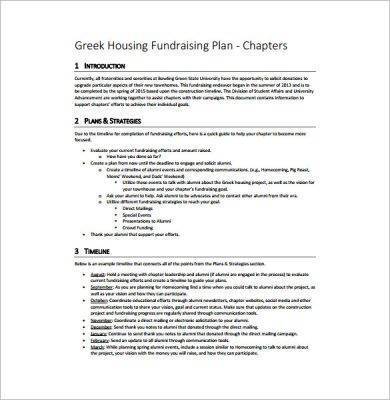10+ Strategic Fundraising Plan Examples to Download
Fundraising refers to the act of collecting contributions in the form of money, services, materials, and other resources that an organization or even an individual can donate to the team who organized the fundraiser to help them with their cause. It can either be for the benefit of a nonprofit organization such as a charity, or for the advantage of a business, a sports team, a civic organization, a musical group, or a college. You may also see weekly plan examples.
Funds are important for whatever group you manage. Without monetary support, your organization can’t go very far. At some point, you will need to seek the assistance of external entities to keep your team from falling apart. However, aside from cash, there are many things that an organization can get from a well-organized fundraising activity. You may also like work plan examples.
Fundraising Strategic Plan Template

Benefits of Fundraising
1. Team Building
A fundraiser is a good excuse to encourage your members to work together. After all, they will be the ones who will reap the products of their own hard work, and they have an obligation to the whole team.
Your efforts to raise money with the help of all of your members may just bring everyone closer together. It will help break down barriers and cliques, because who has the time for that when the organization needs its members to be unified for once? You may also check out daily plan examples.
You can divide your members into smaller teams. A little competition will also be healthy for everyone. You can assign each team a task and make the whole activity a big game for everyone. This will motivate them to work harder and quicker because they have opponents to win against, and it will make the whole chore of organizing an event unbelievably fun. You might be interested in risk plan examples.
A fundraiser is also a great venue where your team members can learn new skills, from their colleagues and from the experience. They can harness these newfound skills in their daily tasks and responsibilities.
2. Promotion
Since you will have to advertise your fundraiser to let people know that there’s actually one that’s going to happen (unless you don’t want an audience), you’re actually going to get the bonus of spreading the word about your organization. This will help increase the public’s awareness about you. You may also see transition plan examples.
For promoting fundraisers, you may have to put up posters around town, make announcements at various local events, run advertisements in the local newspaper, post about it on your social media platforms and websites, and maybe even announce it on the radio and on TV stations.
By going through these measures, you are not only publicly broadcasting your event, you are also spreading the word about your organization. Even if the people who read, hear, and see your advertisements don’t come to your event, they already know about your existence, so its free publicity. You may also like quality plan examples.
3. Good Act
Although money, publicity, and team building are all good motives that can drive you toward organizing a fundraiser, these should not only be your only reason. It’s best if you have a purpose far greater than that, one that will serve not only your interest but that of a bigger population of people. You may also check out sales plan examples.
It could be anything as small as raising awareness to a particular issue or something as big as providing a safe place for orphans. Whatever it is, it should be something that you will feel proud about because you are not simply asking for money. You are asking for money for an endeavor that will have positive effects on other people. You might be interested in annual plan examples.
At the end of the day, irregardless of your event being successful or not, you will still feel good about the whole activity because it will benefit more than yourself. That’s the true essence of fundraisers.
Sample Fundraising Plan
Fundraising Plan Template
Developing a Fundraising Strategy
Creating a fundraising strategy will help you identify the present financial status of your institution. It can help you create financial goals, and set activities and timelines to achieve them. A fundraising strategy will serve as an ever-changing document that will help you bring your organization forward.
With the help of a well-thought-out simple plan, you can understand what projects should be on your priority, which means that allocating your resources will not only be easier, they will also be more effective. It’s also a great tool for communicating your goals and the means to meet them to win the support of other relevant people, and to understand the strengths and limitations of your organization that will have an effect on your fundraising attempts.
Fundraising Plan Example
Greek Housing Fundraising Plan
There is no set template for fundraising strategies. Most organizations just make them up as they go, designing it in a way that will be most effective to them. In any case, it doesn’t really matter how a strategic plan will look as long as it is doing the role it’s supposed to play for the team. However, as with most documents, there are certain elements that need to be constant in a strategic plan such as the following:
Case for Support
It is important that your fundraising strategy will contain the main reason why your organization is existing, because this will be the basis of the vision and the priorities that you will communicate to your donors and to your supporters. You may also see project plan examples.
This part of your strategy will help the public understand the beneficiaries of your organization and the benefits that they receive from you. This will also hold the reason behind your fundraising, and can help you convince the public that your cause is worth supporting. It answers the following questions:
- Who are you and what do you do (as an organization)?
- What problems are you addressing?
- How are you addressing it?
- How will this objective help you achieve your goals as an organization?
- Why should we support this objective?
Example Fundraising Strategy Plan
1. Your Goals
You must eloquently express through your strategy the reason behind your fundraising. It should express a thorough detailing of the projects or programs that the money accumulated will be for, the amount of money it will require, and the length of time needed to accomplish them. If your fundraising is for more than one purpose, your professional goals should be itemized depending on the priority.
2. Your Resources
You should have a clear understanding of your organization’s resources which come in different forms. They may be your staff, your existing budget, or your connections. Your fundraising strategy must include your long-term plan on how to utilize your resources to benefit whatever better goals you have set for your organization (which is also explained in your strategy’s case support), and the means that you will go through to develop the said resources.
3. Your Fundraising Prospects
Fundraising strategies are never blindly looking for goodhearted people willing to support your cause. That is rarely the case because it will most likely be a waste of efforts and resources. On the contrary, most fundraising strategies have set prospects that they can target with their efforts. These can be both individuals or foundations. You may also see job plan examples.
By doing so, you can effectively target your efforts toward one central focus which gives you a higher chance of being successful. But this cannot be performed if you can’t identify your best prospects. You can start by creating a shortlist by scouring through your contacts, looking for people who already have a relationship with your organization, and those who might be willing to start one. You may also like personal plan examples.
4. SWOT Analysis
This strategy is always useful for every organization because it is an invaluable planning tool. It’s a lot like having the ability to predict the negative outcomes of a plan because it assesses its weak points, and anticipating success by looking at the organization’s strong virtues.
However, since we are not trying to focus on your team’s liabilities and fortes, it’s not always necessary to create one for this particular endeavor. But if you want to have one, you can do so by creating a general summary of the main issues, both positive and negative, that directly affect your group, and repeat this process regularly.
5. Your Calendar of Activities
It’s quite a challenge, steering a whole organization toward one common goal. There are a lot of hindrances that may block the way (the main one being procrastination), and this can cause the whole team to lose sight of what they are truly after. You may also check out assessment plan examples.
A calendar of activities will serve as a never-ending deadline that can push your whole group to work hard toward your goal knowing that there are more that they are yet to do after that. It will also make your whole team’s annual goal more concrete since it will literally be posted on a calendar for everyone to see.
2017 SMART Fundraising Goal Plan
Sample Fundraising Strategic Plan Example
Tips for Creating a Foolproof Fundraising Strategy
Creating a strategy is easy. You can just scribble your goals and put dates beside them, and you’re good to go. The real trick is in designing a strategy that will actually be effective. So aside from the elements we’ve discussed above that you can follow in making your strategy, here are also some tips that can be helpful. You may also see event plan examples.
1. Gain input from your present stakeholders.
These people play a big role in sustaining their organization because they give a big percentage of the funding, which means that they also have a say on big decisions like fundraising activities. Before you start implementing your fundraising attempts, make sure you receive their inputs first. You may also like financial plan examples.
You can either ask them for information about your company’s fundraising activities in the past, or you can interview them for their own opinions on what they think should be your organization’s priorities. This will help you take your stakeholders’ ideas to improve your strategic plan.
2. Develop goals.
To be able to effectively work on track and not get sidetracked by any diversion, you must create a clear endpoint that you can actively work toward. Your simple strategic plan’s end product should mirror your team’s main reason for existence. It’s best if you convene with your team for this part.
3. Develop fundraising methods.
Once you have determined a goal, you must now carefully curate the steps you will take to achieve them. Should you set up online donation access for the public? Should you organize fundraising events? You can also refer to your organization’s fundraising history to discover which means have already worked for you, which prospects to pursue, and which methods will serve you best. You may also check out simple business plan examples.
Every organization needs funds, and asking for it from people who are willing to help is not something that you should be ashamed of, especially if it’s for a greater cause.









